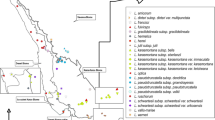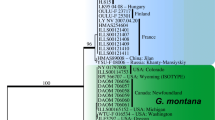Abstract
Electrophoretic surveys of 13 enzyme-coding loci distinguished unambiguously five morphologically defined species of Porites and two species of Goniopora. Each species was identifiable solely by unique, qualitative banding patterns at 1–6 loci. Genetic distances give preliminary estimates that these Porites species diverged from common ancestors 8–22 Ma during the Miocene, and that the two Goniopora species diverged about 3.5 Ma in the Pliocene, assuming Porites evolved from Goniopora 55 million years ago (Ma).
Similar content being viewed by others
References
Aebersold PB, Winans GA, Teel DJ, Milner GB, Utter FM (1987) Manual for starch gel electrophoresis: a method for the detection of genetic variation. NOAA Tech Rep NMFS no. 61
Avise JC (1975) Systematic value of electrophoretic data. Syst Zool 23:465–481
Ayala FJ (1983) Enzymes as taxonomic characters. In: Oxford GS, Rollinson D (eds) Protein polymorphism: adaptive and taxonomic significance. Academic Press, New York, pp 3–26
Bernard HM (1903) The family Poritidae. I. The genus Goniopora. Cat Madreporarian Corals, Br Mus (Nat Hist) 2:1–166
Bernard HM (1905) The family Poritidae. II. The genus Porites, Part I. Porites of the Indo-Pacific region. Cat Madreporarian Corals, Br Mus (Nat Hist) 5:1–303
Blainville HM de (1830) Zoophytes. Dictionnaire des sciences naturelles. Vol 60. Paris, pp 297–364
Brakel WH (1976) The ecology of coral shape: microhabitat variation in the colony form and corallite structure of Porites on a Jamaican reef. PhD Dissertation, Yale University
Crossland C (1952) Madreporaria, Hydrocorallinae, Heliopora and Tubipora. Sci Rep Great Barrier Reef Exped 1926–29. Br Mus (Nat Hist) 6:85–257
Dana JD (1864) Zoophytes. US Exploring Exped 1838–1842. Sherman, Philadelphia 7:1–740
Done TJ, Dayton PK, Dayton AE, Steger R (1991) Regional and local variability in recovery of shallow coral communities: Moorea, French Polynesia and central Great Barrier Reef. Coral Reefs 9:183–192
Felsenstein J (1981) Evolutionary trees from gene frequencies and quantitative characters: finding maximum likelihood estimates. Evolution 35:1229–1242
Forskål P (1775) Descriptiones Animalium, Avium, Amphibiorum, Piscium, Insectorum, Vermium que in intinere orientali observavit Petrus Forskal. IV. Coralli. Hauniae. pp 131–139
Goodman M, Weiss ML, Czelusniak J (1982) Molecular evolution above the species level: Branching patterns, rates, and mechanisms. Syst Zool 31:376–399
Gray JE (1842) Pocilloporidae. In: Synopsis of the contents of the British Museum. 44th ed, London
Harris H, Hopkinson DA (1976) Handbook of enzyme electrophoresis in human genetics. American Elsevier, New York
Highsmith RC (1980) Passive colonization and asexual colony multiplication in the massive coral Porites lutea Milne Edwards. J Exp Mar Biol Ecol 47:55–67
Link HF (1807) Beschreibung der Naturalien Sammlungen der Universitat Rostock 3:161–165
Maragos JE (1977) Order Scleractinia: stony corals. In: Devaney DH, Eldredge LG (eds) Reef and shore fauna of Hawaii. Section 1: Protozoa through Ctenophora. BP Bishop Mus Spec Publ 64:158–241
McManus J (1985) Marine speciation, tectonics and sea-level changes in southeast Asia. Proc 5th Int Coral Reef Congr 4:133–138
Murphy RW, Sites JW Jr, Buth DG, Haufler CH (1990) Proteins I: isozyme electrophoresis. In: Hillis DM, Moritz C (eds) Molecular systematics. Sinauer, Sunderland Mass. pp 45–126
Nei M (1978) Estimation of average heterozygosity and genetic distance from a small number of individuals. Genetics 89:583–590
Nemenzo F (1955) Systematic studies on Philippine shallow water scleractinians: I. Suborder Fungiida. Nat Appl Sci Bull 15:3–84
Potts DC (1983) Evolutionary disequilibrium among Indo-Pacific corals. Bull Mar Sci 33:619–632
Potts DC (1984) Generation times and the Quaternary evolution of reef-building corals. Paleobiology 10:48–58
Potts DC (1985) Sea-level fluctuations and speciation in scleractinia. Proc 5th Int Coral Reef Congr 4:127–132
Potts DC, Budd AF, Garthwaite RL (in press) Soft tissue versus skeletal approaches to species recognition and phylogeny reconstruction in corals. Proc 6th Fossil Cnidarian Symp
Potts DC, Done TJ, Isdale PJ, Fisk DA (1985) Dominance of a coral community by the genus Porties (Scleractinia). Mar Ecol Prog Ser 23:79–84
Potts DC, Garthwaite RL (1991) Evolution of reef-building corals during periods of rapid global change. In: Dudley EC (ed) The unity of evolutionary biology. Dioscorides Press, Portland Oregon 1:170–178
Randall RH, Myers RF (1983) Guide to the coastal resources of Guam: Vol 2. The corals. University of Guam Press, Guam
Richardson BJ, Baverstock PR, Adams M (1986) Allozyme electrophoresis. Academic Press, Sydney
Rosen BR (1984) Reef and coral biogeography and climate through the late Cenozoic: just islands in the sun or a critical pattern of islands. In: Brenchley P (ed) Fossils and climate. Wiley, New York, pp 201–262
Scheer G, Pillai CSG (1983) Report on the stony corals from the Red Sea. Zoologica 45:1–198
Scoffin TP, Stoddart DR (1978) The nature and significance of microatolls. Phil Trans R Soc London Ser B 248:99–122
Selander RK, Smith MH, Yang SY, Johnson WE, Gentry JB (1971) IV. Biochemical polymorphism and systematics in the genus Peromyscus. I. Variation in the old field mouse (Peromyscus polionorua). Studies Genet VI Univ Texas Publ 7103:49–90
Shaklee JB, Allendorf HW, Morizot DC, Whitt GS (1990) Gene nomenclature for protein-coding loci in fish. Trans Am Fish Soc 119:2–15
Stanley SM (1979) Macroevolution: pattern and process. Freeman, San Francisco
Stoddart JA (1983) Asexual reproduction of planulaes in the coral Pocillopora damicornis. Mar Biol 76:279–284
Thorpe JP (1982) The molecular clock hypothesis: biochemical evolution, genetic differentiation, and systematics. Ann Rev Ecol Syst 13:139–168
Vaughan TW (1907a) Recent madreporaria of the Hawaiian Islands and Laysan. US Nat Mus Bull 59:1–427
Vaughan TW (1907b) Some madreporarian corals from French Somaliland, East Africa, collected by Dr. Charles Gravier. Proc US Nat Mus 23:249–266
Vaughan TW (1918) Some shoal-water corals from Murray Islands, Cocos-Keeling Islands and Fanning Island. Pap Dept Mar Biol Carnegie Inst Wash 9 (Publ 213):51–234
Vaughan TW, Wells JW (1943) Revision of the suborders, families, and genera of the Scleractinia. Geol Soc Am Spec Pap 104:1–363
Vawter AT, Rosenblatt R, Gorman GC (1980) Genetic divergence among fishes of the eastern Pacific and the Caribbean: support for the molecular clock. Evolution 34:705–711
Veron JEN (1986) Corals of Australia and the Indo-Pacific. Angus and Robertson, Sydney
Veron JEN, Pichon M (1982) Scleractinia of eastern Australia. Part IV. Family Poritidae. Aust Inst Mar Sci Monogr Ser 5:1–159
Wells JW, Lang JC (1973) Systematic list of Jamaican shallowwater Scleractinians. Bull Mar Sci 23:55–58
Zlatarski VN (1990) Porites colonensis, new species of stony coral (Anthozoa: Scleractinia) off the Caribbean coast of Panama. Proc Biol Soc Wash 103:257–264
Zlatarski VN, Estalella NM (1982) Les scléractiniares de Cuba. Académie Bulgare des Sciences, Sophia
Author information
Authors and Affiliations
Additional information
Correspondence to: R. L. Garthwaite
Rights and permissions
About this article
Cite this article
Garthwaite, R.L., Potts, D.C., Veron, J.E.N. et al. Electrophoretic identification of poritid species (Anthozoa: Scleractinia). Coral Reefs 13, 49–56 (1994). https://doi.org/10.1007/BF00426435
Accepted:
Issue Date:
DOI: https://doi.org/10.1007/BF00426435




